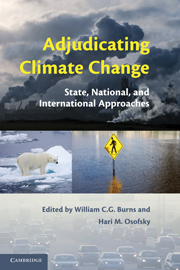Book contents
- Frontmatter
- Contents
- Foreword
- Acknowledgments
- Adjudicating Climate Change
- 1 Overview: The Exigencies That Drive Potential Causes of Action for Climate Change
- PART I SUBNATIONAL CASE STUDIES
- PART II NATIONAL CASE STUDIES
- 6 The Intersection of Scale, Science, and Law in Massachusetts v. EPA
- 7 Biodiversity, Global Warming, and the United States Endangered Species Act: The Role of Domestic Wildlife Law in Addressing Greenhouse Gas Emissions
- 8 An Emerging Human Right to Security from Climate Change: The Case Against Gas Flaring in Nigeria
- 9 Tort-Based Climate Litigation
- 10 Insurance and Climate Change Litigation
- PART III SUPRANATIONAL CASE STUDIES
- 17 Conclusion: Adjudicating Climate Change across Scales
- Index
- References
7 - Biodiversity, Global Warming, and the United States Endangered Species Act: The Role of Domestic Wildlife Law in Addressing Greenhouse Gas Emissions
Published online by Cambridge University Press: 25 August 2009
- Frontmatter
- Contents
- Foreword
- Acknowledgments
- Adjudicating Climate Change
- 1 Overview: The Exigencies That Drive Potential Causes of Action for Climate Change
- PART I SUBNATIONAL CASE STUDIES
- PART II NATIONAL CASE STUDIES
- 6 The Intersection of Scale, Science, and Law in Massachusetts v. EPA
- 7 Biodiversity, Global Warming, and the United States Endangered Species Act: The Role of Domestic Wildlife Law in Addressing Greenhouse Gas Emissions
- 8 An Emerging Human Right to Security from Climate Change: The Case Against Gas Flaring in Nigeria
- 9 Tort-Based Climate Litigation
- 10 Insurance and Climate Change Litigation
- PART III SUPRANATIONAL CASE STUDIES
- 17 Conclusion: Adjudicating Climate Change across Scales
- Index
- References
Summary
INTRODUCTION
On May 15, 2008, the U.S. Fish and Wildlife Service, an executive branch agency within the Department of Interior, issued a regulation listing the polar bear under the Endangered Species Act (ESA), a federal statute designed to prevent the extinction of imperiled plants and animals, due to global warming and the melting of the bear's sea-ice habitat. This highly publicized milestone firmly cemented the polar bear as the iconic example of the devastating impacts of global warming on the planet's biodiversity. While the polar bear is the most well-known species imperiled by global warming, and the first to be listed under the ESA solely due to this factor, it was not the first species protected under the statute in which global warming played a significant role. Two years earlier, on May 9, 2006, the National Marine Fisheries Service, declared two species of Caribbean coral Threatened under the ESA.
The ESA has been declared by the U.S. Supreme Court to be “the most comprehensive legislation for the preservation of endangered species ever enacted by any nation.” The statute is widely considered to be one of the strongest environmental laws in the United States, and hence one of the most controversial. The listing under the ESA of species threatened by global warming raises the possibility of applying this law, which “admits of no exception,” and which affords endangered species “the highest of priorities,” to the seemingly intractable issue of reducing U.S. greenhouse gas emissions.
- Type
- Chapter
- Information
- Adjudicating Climate ChangeState, National, and International Approaches, pp. 145 - 172Publisher: Cambridge University PressPrint publication year: 2009
References
- 1
- Cited by



